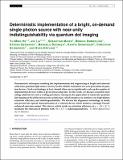Deterministic implementation of a bright, on-demand single photon source with near-unity indistinguishability via quantum dot imaging
Abstract
Deterministic techniques enabling the implementation and engineering of bright and coherent solid-state quantum light sources are key for the reliable realization of a next generation of quantum devices. Such a technology, at best, should allow one to significantly scale up the number of implemented devices within a given processing time. In this work, we discuss a possible technology platform for such a scaling procedure, relying on the application of nanoscale quantumdot imaging to the pillar microcavity architecture, which promises to combine very high photon extraction efficiency and indistinguishability. We discuss the alignment technology in detail,and present the optical characterization of a selected device which features a strongly Purcell enhanced emission output. This device, which yields an extraction efficiency of h = (49 ± 4) %, facilitates the emission of photons with (94 ± 2.7) % indistinguishability.
Citation
He , Y-M , Liu , J , Maier , S , Emmerling , M , Gerhardt , S , Davanço , M , Srinivasan , K , Schneider , C & Höfling , S 2017 , ' Deterministic implementation of a bright, on-demand single photon source with near-unity indistinguishability via quantum dot imaging ' , Optica , vol. 4 , no. 7 , pp. 802-808 . https://doi.org/10.1364/OPTICA.4.000802
Publication
Optica
Status
Peer reviewed
ISSN
2334-2536Type
Journal article
Description
We acknowledge financial support by the State of Bavaria and the German Ministry of Education and Research (BMBF) within the projects Q.com-H. Support by the DFG within the project SCHN1376-2.1 (DACH) is greatfully acknowledged. Y.-M. H. acknowledges support from the Sino-German (CSC-DAAD) Postdoc Scholarship Program. J.-L acknowledges support by the Cooperative Research Agreement between the University of Maryland and NIST-CNST, Award 70NANB10H193, National Natural Science Foundation of China (grant no. 11304102) and the Ministry of Science and Technology of China (grant no. 2016YFA0301300).Collections
Items in the St Andrews Research Repository are protected by copyright, with all rights reserved, unless otherwise indicated.

